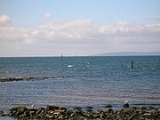
Boyd's Automatic tide signalling apparatus
Encyclopedia
The automatic tide signalling apparatus at Irvine
harbour in North Ayrshire
, Scotland
, is a Grade B Listed Building and is probably unique, having been invented and patented by Martin Boyd, the Irvine harbourmaster, in 1905 and opened in 1906.
and dates, in its present location, from circa 1677, although a military report describes a port in 1566 and by inference one was present in 1514 when the Aldermen and Bailies of Irvine were ordered by the Crown to make ships and crews available for a military expedition against Donald of the Isles
.
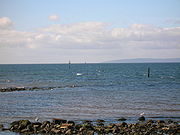 Since the harbour is tidal and the confluence of the Rivers Garnock
Since the harbour is tidal and the confluence of the Rivers Garnock
and Irvine is close to the mouth, the bar constrains the harbour's development. In the 18th century the bar compounded the problem of silting to the extent that in 1753 a government report on Irvine Harbour stated that it was "choked up with sand banks" and vessels were sometimes unable to depart for several months.
In addition to acquiring a dredger in the late 1750s, the Irvine Harbour Authorities constructed stone breastworks facing downstream and projecting at an angle into the river, so that the harbour would be self-cleaning. These are still visible today. Dredging could maintain the required depth of water at the bar, but captains of vessels wishing to enter the harbour had no way of knowing the depth of the water in the channel. The Tidal Harbour Commissioners report on Irvine Harbour in 1847 contained the information that there was a signal post upon an eminence close to the harbour upon which balls are raised to indicate the state of the tide. Tugs and other ships also took the news of the depth of water over the bar to ships waiting in the bay.
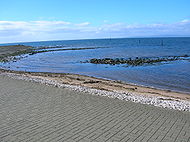
.png) In the early 1900s Irvine was losing trade to two nearby ports, namely Troon
In the early 1900s Irvine was losing trade to two nearby ports, namely Troon
, owned by the Glasgow and South Western Railway Company
, and to Ardrossan
, another railway owned harbour. It was against this background that the Irvine Harbourmaster, one Martin Boyd, of 56 Harbour Street, set about determining ways to improve the access to the harbour and its facilities.
an Automatic Tide Marker Station (ATMS) on 7 May 1903. The introduction to his application for a patent for this ATMS, states that it is to be an apparatus for automatically signalling the depth of water at harbours, docks, piers, navigable channels or the like. A postcard of 1906 shows him standing in front of his tower.
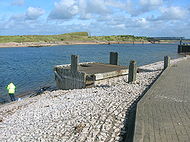 The system entailed the provision of a floating chamber, or 'Tide gauge' (at NS 30369 37993) in this case made of timber, situated at some distance from the structure and calibrated in such a manner as to represent the tide depth at the harbour bar. In the case of Irvine, the bar and the flotation chamber are some distance apart. Within the chamber a wooden float like a raft rose and fell according to the tide. Attached to this float was a cable, which ran through a wooden trough to the building, named the 'Pilot House' by the locals (at NS 30386 37970) which housed the apparatus. Changes in direction, the difference between the actual tide heights and the distance between the balls/lights, was achieved by pulleys and gearing. Within the building the cable was attached to eclipsers, metal frames with wheels which ran on rails attached to the building. The eclipsers, two in number, rose and fell with the tide. As the eclipser rose, it covered apertures through which a gas light had been previously observed. This light, from the main gas supply, was automatically switched off as the eclipser continued up but a by-pass jet always remained alight to maintain a supply to the main jet when the eclipser descended. At night the tide depth was indicated by the use of lights which diminished in number as the tide went out and vice versa.
The system entailed the provision of a floating chamber, or 'Tide gauge' (at NS 30369 37993) in this case made of timber, situated at some distance from the structure and calibrated in such a manner as to represent the tide depth at the harbour bar. In the case of Irvine, the bar and the flotation chamber are some distance apart. Within the chamber a wooden float like a raft rose and fell according to the tide. Attached to this float was a cable, which ran through a wooden trough to the building, named the 'Pilot House' by the locals (at NS 30386 37970) which housed the apparatus. Changes in direction, the difference between the actual tide heights and the distance between the balls/lights, was achieved by pulleys and gearing. Within the building the cable was attached to eclipsers, metal frames with wheels which ran on rails attached to the building. The eclipsers, two in number, rose and fell with the tide. As the eclipser rose, it covered apertures through which a gas light had been previously observed. This light, from the main gas supply, was automatically switched off as the eclipser continued up but a by-pass jet always remained alight to maintain a supply to the main jet when the eclipser descended. At night the tide depth was indicated by the use of lights which diminished in number as the tide went out and vice versa.
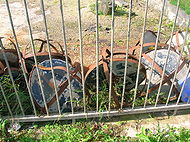
 A code of different colours controlled by the blinds was used. During the hours of daylight, the method of indication was a code of black balls which were fixed to ropes connected to the eclipsers. These ropes were passed over pulleys attached to a cross arm on a staff at the top of the building. The balls were connected at fixed intervals to the rope and, again as the eclipser rose, the rope and the balls fell and disappeared within the building. The distance between each ball was exactly calibrated to tie in with the switching on / off of the lights. To correspond with the change in colour of the lights different shape balls were proposed but never installed. The code of balls / lights indicated by the system involved more balls / lights being displayed as the depth increased, the maximum being twelve balls at 18 feet of depth during the day or four white lights by night.
A code of different colours controlled by the blinds was used. During the hours of daylight, the method of indication was a code of black balls which were fixed to ropes connected to the eclipsers. These ropes were passed over pulleys attached to a cross arm on a staff at the top of the building. The balls were connected at fixed intervals to the rope and, again as the eclipser rose, the rope and the balls fell and disappeared within the building. The distance between each ball was exactly calibrated to tie in with the switching on / off of the lights. To correspond with the change in colour of the lights different shape balls were proposed but never installed. The code of balls / lights indicated by the system involved more balls / lights being displayed as the depth increased, the maximum being twelve balls at 18 feet of depth during the day or four white lights by night.
Adjacent to the Automatic Tide Marker Station building another signal system existed to indicate whether vessels could enter or leave the harbour. On a flag staff, two red lights hung vertically by night or two black balls hung vertically by day, were displayed when a vessel should not enter or leave. At the bar entrance was a white light to the south and northern one which flashed on and off continuously to give skippers their bearings.
Views of the 'Pilot house' - 2007
further up the Clyde Coast. They returned 'suitably refreshed' at 22.00 hrs to carry out a night inspection of the lights. By 22.15 hrs they had re-entered the harbour and were 'completely satisfied with the Automatic Tide Marker Station'.
A newspaper advertisement at the time stated:
"Notice to Mariners - The Irvine Harbour Trustees hereby give notice that they have erected Boyd's patent AUTOMATIC TIDE SIGNALLING APPARATUS, which will be opened on Wednesday 23rd curt., and will from that day exhibit from a tower a code of ball signals. The tower is situated 40 yards or thereby southwards of the present green light".
Views of Irvine harbour - 2007
 The 'Pilot House' was updated with electric lights, adjustments and re-calibration being made to compensate for the silting up of the riverside tank. The system, however fell into disuse in the early 1970s and the building gradually deteriorated to the extent that rain water was penetrating the structure, leading to rot of the upper landing and structure timbers. Settlement of the building resulted in cracks appearing around the window lintels and sills. The float chamber became totally silted up, the connecting wooden trough for the cables disappeared and the signal equipment gradually decayed within the building.
The 'Pilot House' was updated with electric lights, adjustments and re-calibration being made to compensate for the silting up of the riverside tank. The system, however fell into disuse in the early 1970s and the building gradually deteriorated to the extent that rain water was penetrating the structure, leading to rot of the upper landing and structure timbers. Settlement of the building resulted in cracks appearing around the window lintels and sills. The float chamber became totally silted up, the connecting wooden trough for the cables disappeared and the signal equipment gradually decayed within the building.
The building and system have protective listing as a category 'B' structure and in 1989, Irvine Development Corporation (IDC) carried out substantial repairs. Attempts by the Scottish Maritime Museum
and others have been made to restore the unique building and system fully (it is thought however that another similar structure may have been built in Northern France). The building was leased to the Irvine Model Boat Club, and a model railway club were very active some years back (datum 2007), laying model railway track on the site and out onto the grass nearby. Since this time most of the mast has been removed and the structure now has an air of total neglect.
Irvine, North Ayrshire
Irvine is a new town on the coast of the Firth of Clyde in North Ayrshire, Scotland. According to 2007 population estimates, the town is home to 39,527 inhabitants, making it the biggest settlement in North Ayrshire....
harbour in North Ayrshire
North Ayrshire
North Ayrshire is one of 32 council areas in Scotland with a population of roughly 136,000 people. It is located in the south-west region of Scotland, and borders the areas of Inverclyde to the north, Renfrewshire to the north-east and East Ayrshire and South Ayrshire to the East and South...
, Scotland
Scotland
Scotland is a country that is part of the United Kingdom. Occupying the northern third of the island of Great Britain, it shares a border with England to the south and is bounded by the North Sea to the east, the Atlantic Ocean to the north and west, and the North Channel and Irish Sea to the...
, is a Grade B Listed Building and is probably unique, having been invented and patented by Martin Boyd, the Irvine harbourmaster, in 1905 and opened in 1906.
Introduction
The Port of Irvine is situated on the Clyde Coast, sited next to the River IrvineRiver Irvine
The River Irvine is a river flowing through southwest Scotland, with its watershed on the Lanarkshire border of Ayrshire at an altitude of above sea-level, near Drumclog, and SW by W of Strathaven...
and dates, in its present location, from circa 1677, although a military report describes a port in 1566 and by inference one was present in 1514 when the Aldermen and Bailies of Irvine were ordered by the Crown to make ships and crews available for a military expedition against Donald of the Isles
Lord of the Isles
The designation Lord of the Isles is today a title of Scottish nobility with historical roots that go back beyond the Kingdom of Scotland. It emerged from a series of hybrid Viking/Gaelic rulers of the west coast and islands of Scotland in the Middle Ages, who wielded sea-power with fleets of...
.
Silting of the estuary mouth

River Garnock
The River Garnock, the smallest of Ayrshire's six principal rivers, has its source on the southerly side of the Hill of Stake in the heart of the Clyde Muirshiel Regional Park. About a mile and a half south of this starting point the untested stream tumbles over the Spout of Garnock, the highest...
and Irvine is close to the mouth, the bar constrains the harbour's development. In the 18th century the bar compounded the problem of silting to the extent that in 1753 a government report on Irvine Harbour stated that it was "choked up with sand banks" and vessels were sometimes unable to depart for several months.
In addition to acquiring a dredger in the late 1750s, the Irvine Harbour Authorities constructed stone breastworks facing downstream and projecting at an angle into the river, so that the harbour would be self-cleaning. These are still visible today. Dredging could maintain the required depth of water at the bar, but captains of vessels wishing to enter the harbour had no way of knowing the depth of the water in the channel. The Tidal Harbour Commissioners report on Irvine Harbour in 1847 contained the information that there was a signal post upon an eminence close to the harbour upon which balls are raised to indicate the state of the tide. Tugs and other ships also took the news of the depth of water over the bar to ships waiting in the bay.
Competition with other Ayrshire ports.

.png)
Troon
Troon is a town in South Ayrshire. It is situated on the west coast of Scotland, about eight miles north of Ayr and three miles northwest of Glasgow Prestwick International Airport. Lying across the Firth of Clyde, the Isle of Arran can be seen. Troon is also a port with freight and ferry services...
, owned by the Glasgow and South Western Railway Company
Glasgow and South Western Railway
The Glasgow and South Western Railway , one of the pre-grouping railway companies, served a triangular area of south-west Scotland, between Glasgow, Stranraer and Carlisle...
, and to Ardrossan
Ardrossan
Ardrossan is a town on the North Ayrshire coast in south-western Scotland. The name "Ardrossan" describes its physical position — 'ard' from the Gaelic àird meaning headland, 'ros' a promontory and the diminutive suffix '-an' - headland of the little promontory...
, another railway owned harbour. It was against this background that the Irvine Harbourmaster, one Martin Boyd, of 56 Harbour Street, set about determining ways to improve the access to the harbour and its facilities.
Martin Boyd, Harbourmaster
Martin Boyd designed and patentedPatent
A patent is a form of intellectual property. It consists of a set of exclusive rights granted by a sovereign state to an inventor or their assignee for a limited period of time in exchange for the public disclosure of an invention....
an Automatic Tide Marker Station (ATMS) on 7 May 1903. The introduction to his application for a patent for this ATMS, states that it is to be an apparatus for automatically signalling the depth of water at harbours, docks, piers, navigable channels or the like. A postcard of 1906 shows him standing in front of his tower.
The Automatic Tide Marker Station
The tide marker station, called the 'Automatic Tide Signalling Apparatus' was actuated by the rise or fall of the tide or water level and by means of a float connected via wires to the marker station a code of light signals by night and a code of balls or like signals by day were automatically operated. Boyd was reimbursed by the Harbour Authorities the sum of £60.00 to cover his expenses in building the apparatus.How it worked



Adjacent to the Automatic Tide Marker Station building another signal system existed to indicate whether vessels could enter or leave the harbour. On a flag staff, two red lights hung vertically by night or two black balls hung vertically by day, were displayed when a vessel should not enter or leave. At the bar entrance was a white light to the south and northern one which flashed on and off continuously to give skippers their bearings.
The Pilot House
The fifty foot tower which housed the system was completed in 1906 and the external facings of the brick building are harled and painted white to make it visible for some distance from out at sea. To this day it is a useful landmark for users of small craft. Although the building appears as a simple square four story tower, there is only one floor above ground level and above that is a void, housing the actual signal equipment, the balls originally being made of canvas stretched over a metal frame. Situated at each floor level, on the seaward side, is a small landing with ladders connecting to the one above or below. The ladders allowed access to the working equipment of the system, including the lights. Each landing also had a window. The ground floor was used by the harbour pilots as their mess room. As a result of this, the building became known locally as 'The Pilot House.'Views of the 'Pilot house' - 2007
Official opening
On 23 May 1906 the opening ceremony was attended by the Provost of Irvine, members and officials of the Irvine Harbour Trust, Councillors, other prominent citizens and members of the general public. The usual speeches and presentations took place and afterwards the official party left the harbour by the steam paddle tug George Brown, travelling to LargsLargs
Largs is a town on the Firth of Clyde in North Ayrshire, Scotland, about from Glasgow. The original name means "the slopes" in Scottish Gaelic....
further up the Clyde Coast. They returned 'suitably refreshed' at 22.00 hrs to carry out a night inspection of the lights. By 22.15 hrs they had re-entered the harbour and were 'completely satisfied with the Automatic Tide Marker Station'.
A newspaper advertisement at the time stated:
"Notice to Mariners - The Irvine Harbour Trustees hereby give notice that they have erected Boyd's patent AUTOMATIC TIDE SIGNALLING APPARATUS, which will be opened on Wednesday 23rd curt., and will from that day exhibit from a tower a code of ball signals. The tower is situated 40 yards or thereby southwards of the present green light".
Views of Irvine harbour - 2007
The decline of Irvine harbour
The Automatic Tide Marker Station achieved its objectives. However, Irvine harbour's fortunes still declined, partly because of it being a tidal harbour and partly because of intense rivalry from other local ports. Latterly, explosives from the ICI plant were the only cargo handled in the harbour, and this trade ceased in the early 1990s.The abandonment of the automatic tide signalling apparatus

The building and system have protective listing as a category 'B' structure and in 1989, Irvine Development Corporation (IDC) carried out substantial repairs. Attempts by the Scottish Maritime Museum
Scottish Maritime Museum
The Scottish Maritime Museum currently has collections located at two sites in the West of Scotland, both with strong maritime connections. The museums, located in Irvine and Dumbarton, each portray different areas of Scotland’s maritime heritage...
and others have been made to restore the unique building and system fully (it is thought however that another similar structure may have been built in Northern France). The building was leased to the Irvine Model Boat Club, and a model railway club were very active some years back (datum 2007), laying model railway track on the site and out onto the grass nearby. Since this time most of the mast has been removed and the structure now has an air of total neglect.

